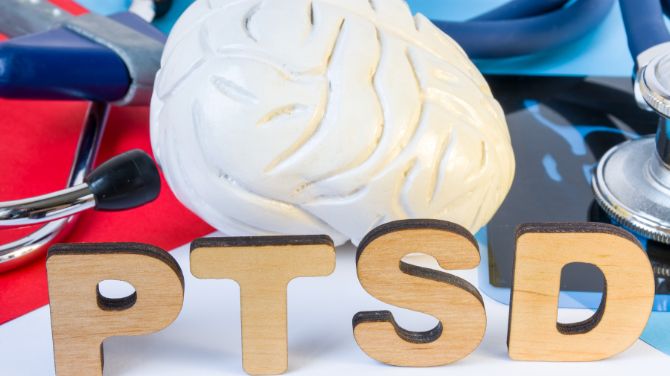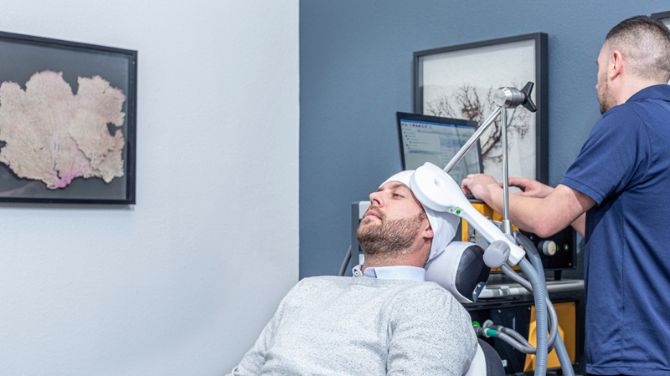Address
440 West Street, Suite 318 Fort Lee, NJ 07024
Contact
Hours
Mon - Fri: 9am - 9pm Sat - Sun: Closed

Post-Traumatic Stress Disorder (PTSD) is a complex mental health condition that arises after experiencing or witnessing a deeply distressing event. It can severely affect daily functioning, relationships, and overall quality of life. While traditional treatments such as medication and psychotherapy have helped many, a significant number of individuals continue to suffer despite trying various approaches. For those facing treatment-resistant symptoms, a breakthrough solution has emerged: Transcranial Magnetic Stimulation (TMS).
This article explores how TMS for PTSD therapy offers new hope for PTSD sufferers, diving into its mechanism, scientific foundation, treatment expectations, and long-term potential.
Post-Traumatic Stress Disorder (PTSD) can manifest in a range of psychological, emotional, and physical symptoms. Common signs include:
1. Intrusive Thoughts:
Individuals may experience distressing memories, nightmares, or flashbacks that make them feel as if they are reliving the traumatic event.
2. Avoidance Behaviors:
People often avoid places, people, or activities that remind them of the trauma. They may also avoid talking or thinking about the event due to the emotional distress it causes.
3. Negative Changes in Thinking and Mood:
This can include persistent negative beliefs about oneself or the world, feelings of detachment, low self-worth, or loss of interest in previously enjoyed activities. Difficulty concentrating and memory problems are also common.
4. Altered Emotional and Physical Reactions:
These may include heightened arousal, irritability, angry outbursts, sleep disturbances, hypervigilance, or an exaggerated startle response.
Recognizing and understanding these symptoms is essential for identifying PTSD and seeking effective treatment. Mental health professionals play a crucial role in diagnosing the condition and recommending appropriate care.
For a diagnosis of TMS for PTSD, symptoms must persist for more than a month and cause significant distress or impairment. It’s also important to differentiate PTSD from other mental health conditions, such as anxiety or depression, which can present with similar symptoms.
A proper assessment will evaluate the duration, severity, and impact of symptoms, while also ruling out other potential diagnoses. This ensures individuals receive the right treatment and support to manage and reduce their symptoms effectively.

Transcranial Magnetic Stimulation is a non invasive procedure that uses magnetic fields to stimulate specific areas of the brain. In the context of TMS for PTSD targets regions associated with mood regulation and emotional control, particularly the prefrontal cortex.
Unlike medications, TMS for PTSD does not flood the brain with chemicals but instead encourages natural neurological adjustment, which many patients find preferable.
Scientific studies have revealed that PTSD is associated with hyperactivity in the amygdala and hypoactivity in the prefrontal cortex. TMS for PTSD helps restore this balance by stimulating and reorganizing neural pathways.
This makes it a promising option not only for PTSD but also as a Resistant Depression Treatment, given the overlap in neural dysfunction across both conditions.

Traditional treatments for PTSD include cognitive behavioral therapy (CBT), exposure therapy, and medications. However, these methods may not work for everyone or may involve side effects. Many people also explore how lifestyle factors like caffeine anxiety impact their symptoms and overall treatment effectiveness.
TMS for PTSD stands out for its non-invasive nature, minimal side effects, and targeted neurological benefits.
The first session includes consultation and brain mapping, followed by electromagnetic stimulation.
Multiple sessions over several weeks are typically needed for best results.
TMS is best suited for individuals who have tried at least one form of traditional PTSD treatment without success.
A comprehensive evaluation by a medical provider will determine eligibility.
Although results vary, TMS therapy continues to show great promise for many who have struggled for years without relief.
TMS for PTSD is generally well tolerated, with very few side effects.
These symptoms usually subside quickly and are not typically serious, making TMS a low-risk option for long-term therapy.
Veterans often experience PTSD due to combat or traumatic military experiences. Many VA hospitals are beginning to implement TMS as part of their treatment protocol.
This shift to modern, non-pharmacological care offers new hope to those who have served.
TMS not only treats symptoms but also promotes lasting neurological improvement through consistent stimulation and brain plasticity.
For many patients, the effects of TMS persist well beyond the initial treatment cycle, especially when followed by occasional maintenance sessions.
While TMS for PTSD can be expensive, many insurance plans now cover it, particularly when traditional treatments have failed.
Many providers assist patients through the insurance process, easing the financial burden.
PTSD is a debilitating condition, but innovative treatments like TMS for PTSD are paving the way toward lasting relief. With its non-invasive nature, minimal side effects, and science-backed effectiveness, TMS provides new hope for those who have struggled with traditional methods.
Whether you’re a veteran, someone facing resistant depression, or simply searching for a modern treatment that works, TMS for PTSD could be your turning point. If you’re wondering whether this therapy is right for you, start by consulting a tms provider near me, such as specialists like Dr. Yuli Fradkin at HWS Center, who focus on brain-based treatment solutions.
Healing from PTSD is not only possible it starts with understanding your options. And now, with TMS for PTSD, a brighter path to recovery is within reach.
440 West Street, Suite 318 Fort Lee, NJ 07024
Mon - Fri: 9am - 9pm Sat - Sun: Closed
HWS Center © 2025 | All rights reserved | For Ketamine Treatment NJ | Created by Invisio Solutions Ltd